Italian ceramics have captivated collectors and decorators for centuries with their hand-painted artistry and vibrant craftsmanship. But behind every authentic piece lies a unique clue, the pottery mark. Understanding these marks is key to determining a ceramic’s origin, age, and authenticity. Whether you’re a casual buyer or an art collector, this Italian pottery marks identification guide will help you recognize genuine craftsmanship from replicas and appreciate the heritage of Italy’s ceramic-making regions.
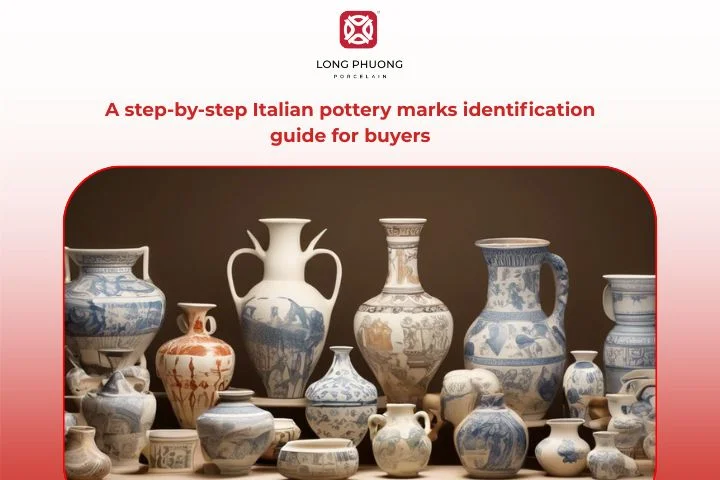
1. What are Italian pottery marks?
In the simplest terms, an Italian pottery marks identification guide is a permanent signature or symbol impressed, painted, or stamped onto a ceramic object. For Italian ceramics, these marks serve several crucial functions:
- Manufacturer Identity: They name the factory, workshop, or individual artist who created the piece.
- Location and Origin: They often pinpoint the town or region of production (e.g., Faenza, Deruta). This is vital, as different regions specialize in different styles.
- Time Period: While not always an exact date, the style and specific details of a mark can help estimate the period of manufacture.
- Quality and Authenticity: An authentic, documented mark is the strongest evidence of a piece’s provenance and traditional craftsmanship.
These marks are the ‘DNA’ of the pottery, a tiny yet powerful bit of history left by the artisan.

See more: exploring vietnamese ceramics: tradition meets modern design
2. Origin and history of Italian pottery marks
The practice of marking pottery in Italy dates back to the Renaissance period when master artisans began signing their creations to ensure authenticity. During the 16th century, towns like Deruta and Faenza gained fame for producing majolica – a tin-glazed earthenware decorated with colorful designs.
As trade expanded, these towns started stamping or inscribing their pottery with distinct symbols to differentiate authentic Italian pieces from cheaper imitations. By the 19th and 20th centuries, the phrase “Made in Italy” became an international standard, ensuring that genuine Italian ceramics could be easily recognized abroad.
Today, Italian pottery marks identification guide remain a vital link to the traditions of ceramic craftsmanship, carrying forward both artistic and cultural identity.

3. 4 types of Italian pottery marks you should know
Identifying the type of mark on your pottery is the first step toward understanding its origin. Below are the four main types of Italian pottery marks identification guide you’ll encounter.
3.1. Impressed or incised marks
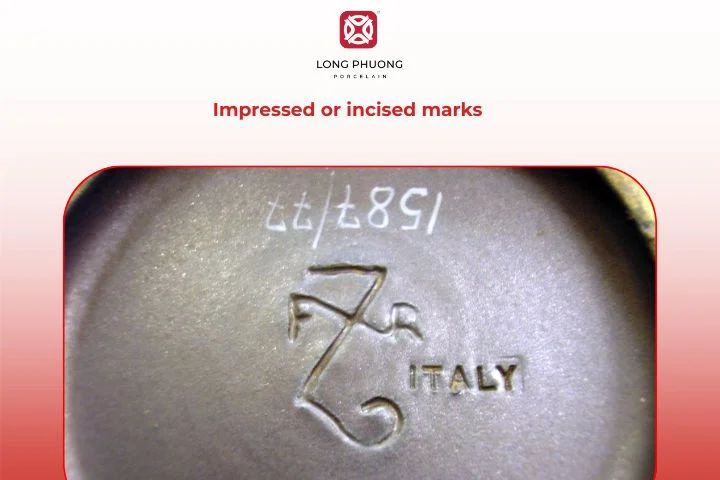
These are marks pressed or carved into the clay before firing. They often appear as subtle engravings or initials. You’ll find them on older handmade pieces where artisans left personal signatures or workshop stamps.
3.2. Painted marks

Painted marks are hand-drawn onto the glazed surface, usually with a fine brush. These may include the artist’s name, a motif, or the town of origin. Since they’re manually applied, they can vary slightly from piece to piece, adding to their uniqueness.
3.3. Printed or stamped marks

These marks became common in the industrial era. Factories used ink or transfer stamps to apply consistent branding. You might see clear text such as “Made in Italy” or a printed logo. They’re helpful for identifying 20th-century ceramics.
3.4. Paper Labels
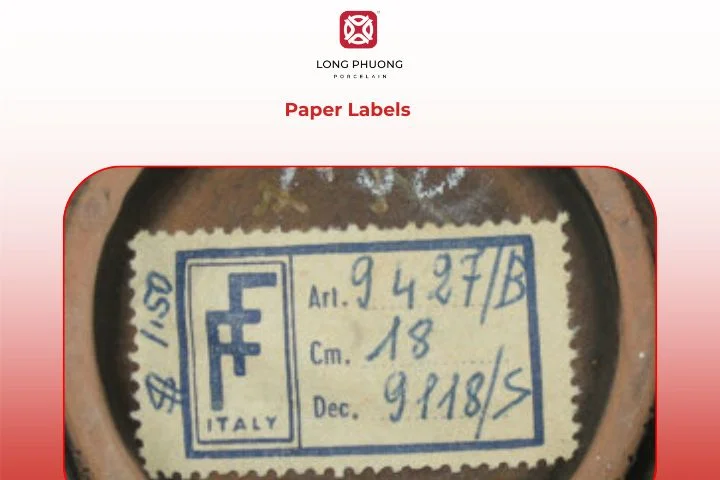
Although temporary, paper labels were used widely during export in the mid-1900s. These labels usually carried the workshop name or export company. While many have been lost over time, finding one still attached can help pinpoint a piece’s origin.
4. Step-by-Step guide to identify Italian pottery marks
Now that you know the different types, let’s go through a simple step-by-step Italian pottery marks identification guide to help you examine any piece confidently.
4.1. Step 1: Examine the bottom of the piece

Flip your pottery carefully and look at the base. Most marks are located there. Use good lighting to inspect small or faint details, sometimes they’re hard to spot under glaze.
4.2. Step 2: Identify key marking types
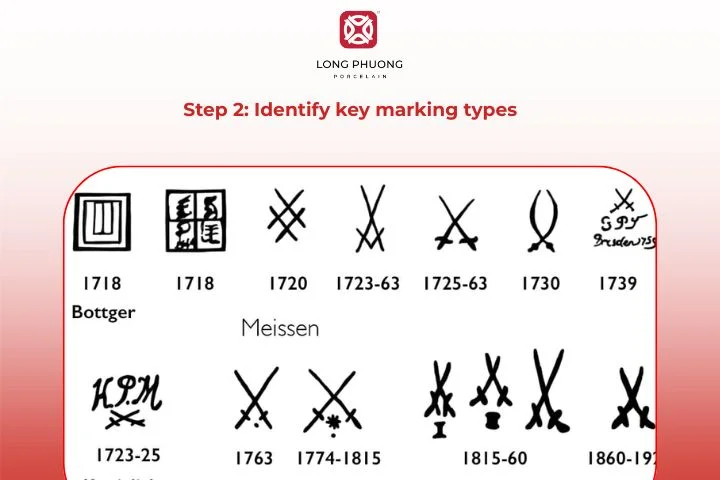
Determine whether the mark is incised, painted, stamped, or labeled. This tells you a lot about the period and method of production. Handmade marks usually suggest an earlier or artisanal piece.
4.3. Step 3: Match symbols and fonts
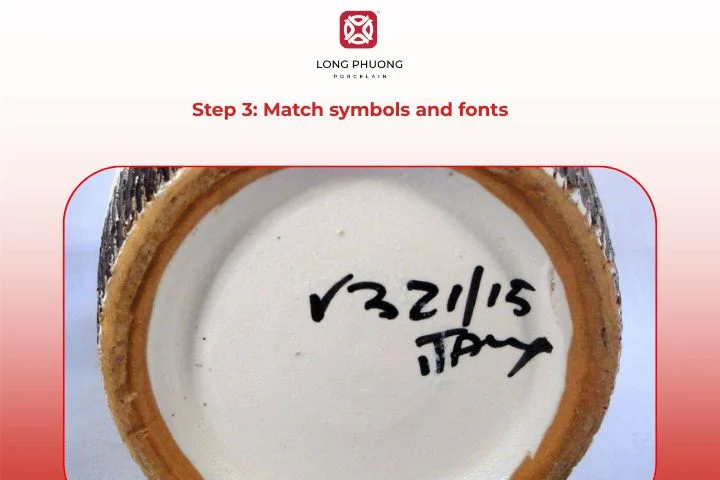
This is where the real detective work begins. Italian marks often feature common themes:
- Crowns and Royalty: (e.g., Capodimonte’s crowned ‘N’)
- Animals and Nature: (e.g., a hand, a symbol of the workshop)
- Region-Specific Text: Look for city names like DERUTA, FAENZA, VIETRI, or names like GINORI.
- Initials and Monograms: These are often the first letters of the factory’s name (e.g., F.A. for Fratelli Agnino).
Pay close attention to the font. Older marks often use more elaborate, decorative scripts, while newer marks are blockier and simpler.
4.4. Step 4: Cross-reference with trusted sources

Once you have a description (e.g., blue painted crown over N or incised D with an animal), you must cross-reference it.
- Reference Books: Classic guides and specialized books on Italian marks are invaluable.
- Online Databases: Search for the specific key phrase: italian pottery marks identification guide plus the symbol/name you found (e.g., italian pottery marks identification guide faenza eagle).
- Regional Specialization: If the piece is a vibrant majolica plate, focus your search on marks from major majolica centers like Deruta or Faenza.
4.5. Step 5: Confirm authenticity and age

- Consistency: Does the mark’s style (font, application) match the known period and style of the pottery itself? A modern, bright piece with a very old, crudely incised mark should raise a red flag.
- Fakes: Be aware of common fake marks (especially the Capodimonte Crowned ‘N’). Fakes are often too clean, too sharp, or appear on pieces made of the wrong material. Look for signs of age around the mark—crazing, wear, or slight discoloration—that should naturally occur over time.
- Expert Appraisal: For high-value or highly-disputed pieces, the final step is seeking a certified appraiser specializing in Italian ceramics.
5. Common Italian pottery marks by region
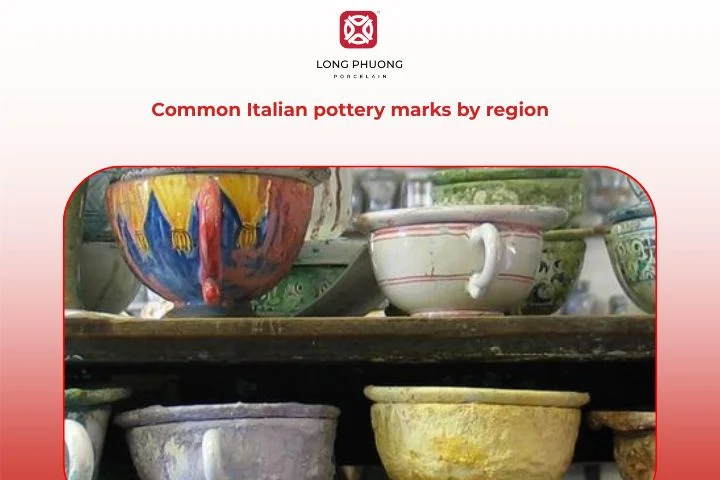
Italy’s ceramic heritage is highly regional. Understanding the styles associated with key locations will greatly assist your italian pottery marks identification guide efforts.
5.1. Deruta
- Style: Famous for majolica (earthenware with a tin-oxide glaze) and Renaissance motifs, particularly the Raffaellesco dragon/grotesque designs.
- Marks: Often features the word DERUTA (sometimes hand-painted) or factory marks within a crest or shield. Look for a strong presence of hand-painted marks on the reverse.
5.2. Faenza
- Style: This city gave the world the term faience. Known for intricate decoration, particularly in the Renaissance, and later for neoclassical designs.
- Marks: Early marks were incised or painted monograms. Later 20th-century pieces feature the city name and factory initials (e.g., F.A.I.R. – Faenze).
5.3. Nove & Bassano
- Style: Known for fine figures, tableware, and a unique style often featuring molded flowers and fruit, especially in the 18th century.
- Marks: Frequently used impressed marks like NOVE or factory initials. The Capri factory mark is also linked to the region.
5.4. Capodimonte
- Style: The epitome of Italian porcelain, famous for delicate figurines and detailed tableware, known for its soft-paste body.
- Marks: The most famous mark is the Crown Over Neapolitan ‘N’ (often in underglaze blue) used after 1771. Earlier pieces used the Fleur-de-lis (see section 4.4). Be extremely cautious, as this is the most faked Italian mark.
5.4. Vietri sul Mare
- Style: Characterized by vibrant, colorful designs that reflect Mediterranean life: sun, sea, and fish. Post-WWII ceramics are highly collected.
- Marks: Modern pieces often have “Vietri” or the factory name (e.g., Solimene) hand-painted or stamped on the base, reflecting the vibrant studio culture.
6. Tips to avoid misidentifying or buying fakes Italian pottery
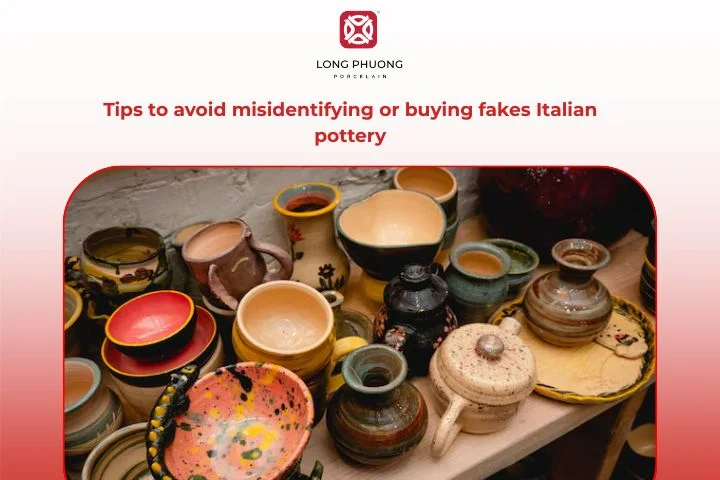
Navigating the market requires a keen eye. Use this italian pottery marks identification guide to spot warning signs:
- Avoid too-perfect marks: Genuine hand-painted marks often have small imperfections or uneven strokes.
- Check the glaze texture: Authentic Italian pottery has a smooth but slightly irregular surface due to hand-finishing.
- Research the seller: Buy from reputable galleries, antique shops, or certified artisans.
- Look for provenance: Ask for documentation or certificates when buying high-value pieces.
- Compare prices: If the price seems too low for fine Italian porcelain, it’s worth questioning its authenticity.
7. Caring for and displaying Italian pottery

Once you’ve authenticated your piece using this Italian pottery marks identification guide, proper care is key to preservation:
- Cleaning: Use mild soap and lukewarm water. Avoid dishwashers, especially for antique pieces, as the aggressive detergents and high heat can damage the glaze and painted marks.
- Display: Keep pieces out of direct, strong sunlight, which can fade painted colors over long periods.
- Handling: Always lift the pottery by the body, not the handles or rims, especially with delicate porcelain figurines like those from Capodimonte.
8. FAQ

This section addresses the most common questions collectors have when using an italian pottery marks identification guide.
Q1: Can pottery marks tell the exact date?
Rarely. Marks typically indicate a period of use for that specific mark (e.g., “Factory X used this mark from 1920-1940”). Precise dating requires cross-referencing the mark with factory production records, if they exist, or the specific design/pattern number.
Q2: Are all authentic Italian ceramics marked?
Most are, but not all. Especially in earlier centuries, some artisans didn’t sign every piece. Context, design, and craftsmanship can still help verify authenticity.
Q3: What does “Made in Italy” vs “Handmade in Italy” mean?
– Made in Italy is a geographical label, often required for export, indicating the product was finished in Italy, but it doesn’t guarantee hand-craftsmanship.
– Handmade in Italy or similar phrasing (often stamped or painted) is a stronger indicator that the piece was crafted using traditional, hands-on methods, though you should still look for brush strokes or signs of hand-throwing.
Q4: What if my pottery doesn’t have a mark?
Lack of a mark doesn’t always mean it’s fake. Some handmade pieces lost their marks due to wear or glaze application. Examine design and quality carefully.
Q5: How can I confirm authenticity?
Follow all the steps in this Italian pottery marks identification guide:
1. Verify the mark type and symbol.
2. Match the mark to a known maker/era.
3. Check the physical characteristics (clay body, glaze texture, hand-painting evidence) against known factory standards.
4. Get an expert appraisal for definitive confirmation.
Q6: What is the app that identifies pottery marks?
Apps like Kovels and Marks4Antiques can help identify ceramic marks. However, cross-checking results with trusted sources is still essential for accuracy.
Related articles
CEO of Long Phuong Group Joint Stock Company, with more than 20 years of exploration and research to obtain the best formulas and professional experience, Long Phuong Porcelain has produced more than 400 designs of all kinds of household porcelain, Significant contributions to Vietnam's ceramic industry.
 Vietnam
Vietnam
